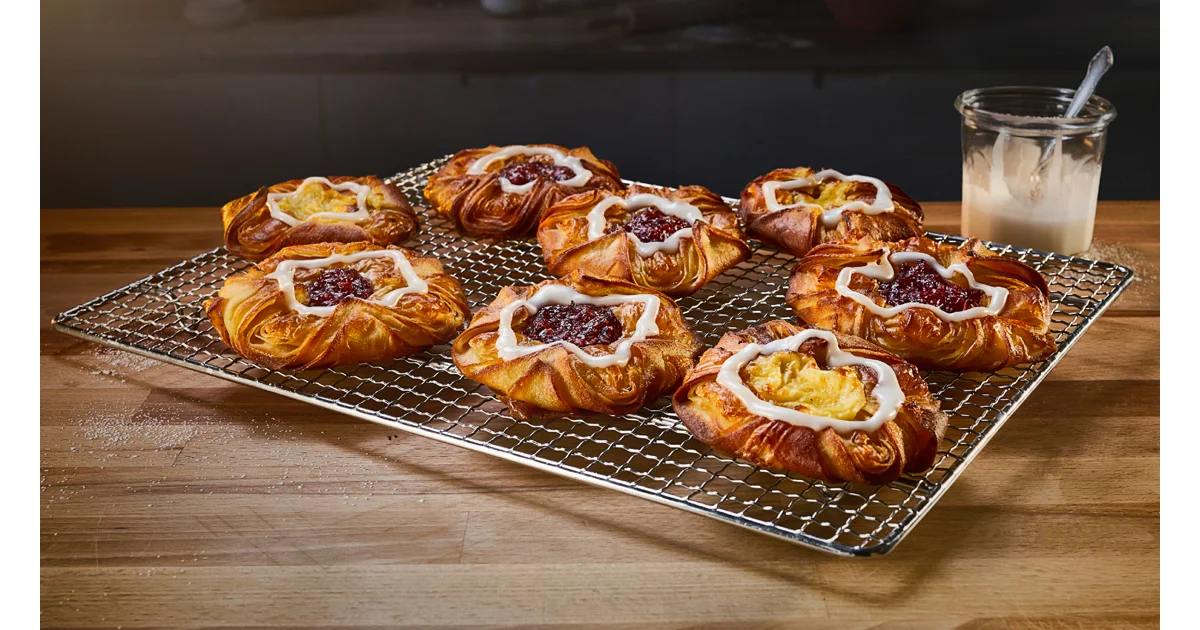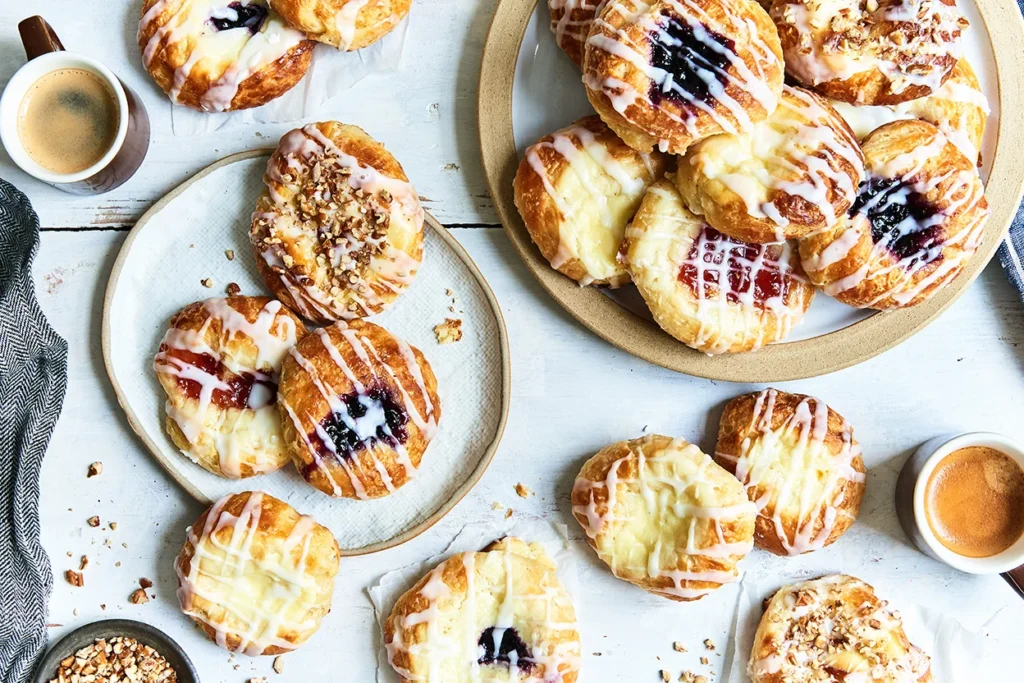Imagine sinking your teeth into a golden, buttery layer that shatters with a satisfying crunch, revealing a hidden treasure of creamy custard, tart fruit, or spiced cinnamon swirls. That’s the decadent magic of Danish pastries—a timeless indulgence that transforms ordinary mornings into extraordinary feasts. Whether you’re a baking enthusiast craving the thrill of laminated dough mastery or a food lover hunting for the world’s most mouthwatering bites, this comprehensive guide unlocks the secrets of Danish pastries. From their surprising Viennese roots to innovative vegan twists, we’ll explore every flaky facet to satisfy your cravings and boost your culinary confidence.

Danish pastries, often simply called “Danishes” in the U.S., are more than just a bakery staple; they’re a symphony of textures and flavors born from centuries of craftsmanship. In Denmark, they’re affectionately known as wiener (Viennese bread), a nod to their Austrian origins. These irresistible treats have conquered global palates, gracing breakfast tables, afternoon fila sessions, and lavish brunches alike. But what makes them so addictive? It’s the perfect harmony of yeasted dough, luxurious butter layers, and endless filling possibilities.
The Fascinating History of Danish Pastries: From Vienna to Global Icon
The story of Danish pastries is a tantalizing tale of strikes, immigration, and culinary innovation that spans continents and centuries. Contrary to their name, these flaky wonders didn’t originate in Denmark at all. Their roots trace back to 19th-century Vienna, Austria, where the art of laminated dough—think croissants and puff pastry—flourished in the hands of skilled bakers. The technique, involving repeated folds of butter into yeast dough, created those signature airy, shatteringly crisp layers we crave today.
The pivotal moment arrived in 1850 during a bakers’ strike in Copenhagen. Danish bakery owners, desperate to keep ovens firing, hired Austrian immigrants to fill the void. These Viennese artisans brought their wienerbrød expertise, blending it seamlessly with local Danish traditions of hearty, sweet breads. The result? A hybrid pastry that exploded in popularity, earning the affectionate moniker wienerbrød in Denmark. By the late 1800s, these treats were a staple in every Copenhagen café, symbolizing hygge—the Danish art of cozy contentment.
Fast-forward to the 20th century, and Danish pastries embarked on a transatlantic journey. In the early 1900s, Danish immigrants in the U.S. Midwest, particularly in Racine, Wisconsin, opened bakeries that adapted the recipe for American tastes. Places like O&H Danish Bakery (established in 1912) refined the pastries with bolder fillings like cheese and fruit, birthing the “Danish” we know today. This evolution turned a European delicacy into a breakfast icon, with annual U.S. consumption soaring into the millions.

But the history isn’t without drama. World Wars disrupted butter supplies, forcing bakers to innovate with margarine— a dark chapter that thankfully ended post-1945. Today, Danish pastries symbolize resilience and fusion cuisine, celebrated in festivals like the annual Kringle Festival in Wisconsin. For a deeper dive into their origins, check out the detailed timeline on Wikipedia’s Danish pastry page. As you munch on your next bite, remember: every flake tells a story of bold bakers defying odds to deliver pure joy.
What Sets Danish Pastries Apart: The Magic of Laminated Dough and Beyond
In a world of mediocre muffins and soggy scones, Danish pastries reign supreme thanks to their unparalleled texture and flavor profile. The secret weapon? Laminated dough—a labor-intensive process that traps steam from butter layers during baking, yielding those ethereal, sky-high rises and shatter-proof crusts. Unlike simple yeast breads, this dough starts with a rich base of flour, milk, yeast, sugar, eggs, and butter, then gets folded around a massive slab of chilled butter (often 1:1 ratio to flour!). Multiple turns—typically three rounds of folding and chilling—create hundreds of ultra-thin layers.
This technique demands precision: dough must stay cool to prevent butter from melting into the mix, which would result in dense, chewy disaster. Pro tip: Use a marble rolling pin chilled in the freezer for flawless execution. The payoff? A pastry that’s crisp outside, tender inside, with buttery aroma that wafts through your kitchen like a warm embrace.
But it’s not just the dough; fillings elevate the ordinary to extraordinary. Traditional Danish pastries favor remonce (almond paste) or custard, while American variants lean into fruit preserves and cream cheese. Glazes—simple sugar icing or pearl sugar crunch—add that irresistible sparkle. What truly distinguishes them from croissants? Yeast in the base dough gives a subtle chewiness and sweetness, making Danishes more forgiving for home bakers.
Exploring the Irresistible Varieties of Danish Pastries: A World of Sweet Surprises
Danish pastries aren’t one-size-fits-all; they’re a vibrant family of flavors, each with its own personality and backstory. From humble custard squares to elaborate braided kringle, these varieties showcase endless creativity. Let’s break down the must-try types that will tantalize your taste buds and inspire your next bake.

Classic Spandauer: The Custard-Filled Heart of Danish Tradition
At the core of wienerbrød culture is the spandauer—a square pastry pinched at corners to cradle a dollop of velvety custard or remonce. Originating as “spand” (scraps) from dough trimmings, it evolved into Denmark’s everyday hero. Bite into one, and the flaky exterior yields to a creamy, vanilla-kissed center that’s pure comfort. For cheese lovers, the American cheese Danish amps up the tang with sweetened cream cheese, often topped with lemon glaze for zing.
Why it’s unbeatable: Its simplicity lets premium ingredients shine. Pair with fresh berries for a fruity twist, or bake mini versions for parties. In Copenhagen bakeries, spandauer outsells all others—proof of its timeless appeal. Discover our internal cheese Danish recipe variation for a quick home win.
Fruit-Filled Wonders: Bursting with Juicy, Seasonal Bliss
Nothing screams freshness like a fruit Danish, where laminated layers hug vibrant jams or poached fruits. Raspberry, apricot, or blueberry fillings dominate, their tartness balancing the dough’s richness. In summer, wild berry versions evoke Danish countryside picnics; winter calls for apple-cinnamon hybrids.
These pastries are nutritional ninjas—antioxidant-packed fruits cut through buttery indulgence. Pro hack: Use homemade chia jam for natural sweetness and fiber boost. Globally, they’re a brunch staple, often glazed with apricot preserves for shine. For berry bliss, try our internal fruit pastry collection.
Cinnamon Snegl and Beyond: Spiced Swirls and Nutty Delights
The snugly (snail) is a cinnamon roll’s flakier cousin—a coiled spiral dusted with pearl sugar, oozing brown butter and spice. It’s hygge in pastry form, perfect for chilly mornings. Then there’s the kringle, a massive oval braid filled with almonds, iconic in Wisconsin’s Danish heritage.
Master the Art: How to Bake Perfect Danish Pastries at Home
Dreaming of bakery-fresh Danish pastries without the hefty price tag? Roll up your sleeves—this foolproof guide demystifies the process, from dough to dazzle. With practice, you’ll whip up batches that rival pros. Patience is key: The lamination takes time, but the aroma alone is worth it.
Ingredients for the Ultimate Danish Dough (Makes 12 Pastries)
For the dough:
- 3 1/2 cups (500g) all-purpose flour
- 1/4 cup (50g) granulated sugar
- 2 1/4 tsp (1 packet) active dry yeast
- 1 tsp salt
- 1 cup (240ml) warm milk
- 1 large egg
- 1/4 cup (60g) softened unsalted butter
For lamination:
- 2 1/2 sticks (285g) cold unsalted butter, softened but cool
Fillings (choose one):
- Custard: 1 cup milk, 1/4 cup sugar, 2 egg yolks, 2 tbsp cornstarch, 1 tsp vanilla
- Cheese: 8oz cream cheese, 1/4 cup sugar, 1 egg yolk, 1 tsp lemon zest
- Fruit: 1 cup jam or poached fruit
Glaze: 1 cup powdered sugar, 2 tbsp milk, 1/2 tsp vanilla
Step-by-Step Mastery: Your Path to Pastry Perfection
- Activate the Yeast Base (10 mins + 1hr rise): In a stand mixer, combine flour, sugar, yeast, and salt. Add warm milk and egg; mix until a shaggy dough forms. Knead in softened butter until smooth (5-7 mins). Cover and let rise in a warm spot until doubled—about 1 hour. This yeasted foundation adds that signature chew.
- Prepare the Butter Block (5 mins): On parchment, shape cold butter into an 8×10-inch rectangle. Chill while dough rises. Butter quality matters—opt for European-style with high fat content for superior flake.
- Laminate Like a Pro (30 mins active + 2hrs chilling): Roll risen dough into a 12×16-inch rectangle on a floured surface. Place butter block in center; fold dough edges over like a letter. Roll to 12×18 inches, fold into thirds (first turn). Chill 30 mins. Repeat rolling and folding twice more, chilling between each. This creates 729 layers—pure wizardry!
Visualize the transformation with these steps:
- Shape and Fill (20 mins): Roll final dough to 1/4-inch thick; cut into 4-inch squares. For spandauer, add 1 tbsp filling to center, pinch corners to enclose. For spirals, roll and slice. Place on parchment-lined sheets; cover and proof 30 mins until puffy.
- Bake to Golden Glory (15-20 mins): Preheat oven to 400°F (200°C). Egg-wash tops for shine; bake until deep gold. Cool slightly.
- Glaze and Garnish (5 mins): Drizzle icing; sprinkle almonds or powdered sugar. Serve warm for melt-in-mouth bliss.
Insider Tips for Flawless Results
- Temperature control: Work in a cool kitchen; if butter softens, re-chill.
- Common pitfalls: Overworking dough leads to toughness—gentle handling is key.
- Make-ahead magic: Dough freezes beautifully; thaw overnight for fresh bakes.
- Variations: Add cardamom to dough for Scandinavian flair, or swap fillings for savory ham-cheese twists.
Where to Find the World’s Best Danish Pastries: A Globetrotter’s Dream
Craving authenticity? Skip the supermarket shelf—these iconic spots deliver Danish pastries at their pinnacle. From Copenhagen’s hygge havens to U.S. immigrant legacies, here’s your roadmap to rapture.
In Denmark, start at Meyers Bageri in Copenhagen: Claus Meyer’s organic haven crafts wood-fired wienerbrød with heirloom grains. Their spandauer, laced with house-made custard, is poetry on a plate. Nearby, Juno the Bakery elevates with sourdough-laminated twists—think miso-caramel snegl for avant-garde allure. For tradition, Lagkagehuset chains offer reliable kringle, but hunt hidden gems like Sankt Peders Bageri for butter-drenched faktura.
Stateside, Wisconsin reigns: Bentsen’s Bakery in Racine serves massive almond Kringle flown nationwide. In New York, Danish outpost Meyers Bagri outpost mirrors Copenhagen vibes. California’s La Lune in Los Angeles fuses French techniques for hybrid Danishes that shatter expectations.
Globally, Tokyo’s Andersen Bakery honors Danish roots with matcher-infused varieties, while London’s Barbeque channels Nordic purity. Pro tip: Visit during holidays for seasonal specials like peppercorn-spiced logs. For more on Danish food trails, explore Visit Denmark’s pastry guide.
Perfect Pairings: Elevate Your Danish Pastry Experience with Expert Matches
Danish pastries shine solo, but masterful pairings turn them into symphonies. Coffee is king—bold espresso cuts through sweetness, while milky lattes temper spice in a snugly. In Denmark, filter cafe (drip coffee) is the ritual staple, evoking cozy mornings.
Tea lovers, try Earl Grey’s bergamot notes with fruit Danishes, or chai’s warmth with almond-filled ones. For indulgence, champagne brunch: Bubbles’ acidity balances richness, perfect for cheese varieties. Non-alcoholic? Sparkling apple cider echoes Danish orchards.
Healthier Twists: Indulge Guilt-Free with Vegan and Low-Calorie Danish Magic
Who says flaky can’t be fit? Modern twists make Danish pastries accessible for wellness warriors. Swap butter for coconut oil in vegan dough; almond milk keeps it creamy. Chia seed jam replaces sugar-laden fruit fillings, packing omega-3s and fiber.

Low-cal hacks: Greek yogurt in cheese mixes cuts fat by 50%, while spelt flour adds nutty wholesomeness. Air-fryer baking slashes oil needs without sacrificing crunch. These adaptations retain 90% of the flavor, proving indulgence and health coexist.
Frequently Asked Questions About Danish Pastries
What’s the difference between Danish pastries and croissants?
Croissants are pure laminated dough; Danishes add yeast and fillings for sweetness and chew.
Can I freeze Danish dough?
Yes! Laminate, wrap tightly, and freeze up to 3 months. Thaw overnight before shaping.
How do I achieve perfect flakiness?
Chill everything—dough, butter, even tools. Avoid warm kitchens.
Are Danish pastries gluten-free possible?
Absolutely, with GF flour blends, though texture softens slightly.